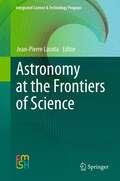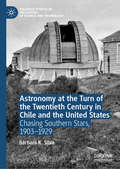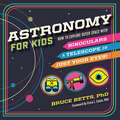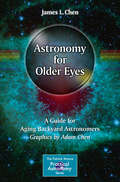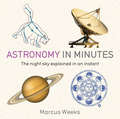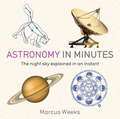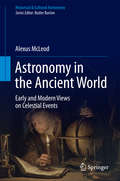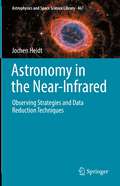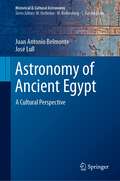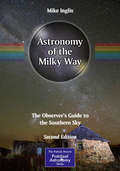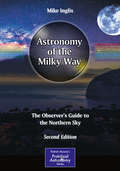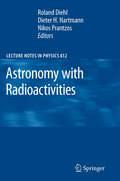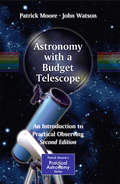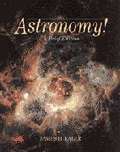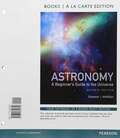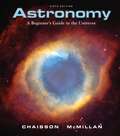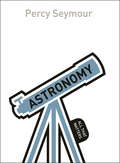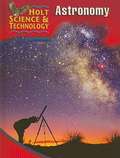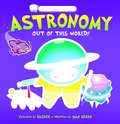- Table View
- List View
Astronomy at the Frontiers of Science (Integrated Science & Technology Program #1)
by Jean-Pierre LasotaAstronomy is by nature an interdisciplinary activity: it involves mathematics, physics, chemistry and biology. Astronomers use (and often develop) the latest technology, the fastest computers and the most refined software. In this book twenty-two leading scientists from nine countries talk about how astronomy interacts with these other sciences. They describe modern instruments used in astronomy and the relations between astronomy and technology, industry, politics and philosophy. They also discuss what it means to be an astronomer, the history of astronomy, and the place of astronomy in society today.
Astronomy at the Turn of the Twentieth Century in Chile and the United States: Chasing Southern Stars, 1903–1929 (Palgrave Studies in the History of Science and Technology)
by Bárbara K. SilvaThis Palgrave Pivot tells the transnational story of the astronomical observatory in the hills near Santiago, Chile, built in the early twentieth century through the efforts of astronomers from the Lick Observatory in California. Venturing abroad to learn from largely unmapped Southern skies and, hopefully, answer lingering questions about the structure of the galaxy, they planned a three-year research expedition—but ended up staying for more than twenty-five years. The history of the Mills Expedition offers a window onto the history of astronomy, the challenges of scientific collaboration across national lines, and the political and cultural contexts of early-twentieth-century Chile and the United States.
Astronomy for Kids: How to Explore Outer Space with Binoculars, a Telescope, or Just Your Eyes!
by Dr. Bruce BettsIgnite their passion for exploring the night sky—the astronomer's guidebook for kids ages 7 to 13"No matter how many times you've orbited the Sun, Astronomy for Kids is really for kids of all ages. Dr. Betts shows you how to become an astronomer—an observer of the stars. With this book, you can know the cosmos and your place within it. Read on, walk out, and look up!"—Bill Nye, science educator, author, and CEO of The Planetary SocietyOne of the coolest things about outer space is that anyone can explore it. All you have to do is go outside and look up! Using plain sight, binoculars, or a small telescope, Astronomy for Kids shows stargazers how easy it is to explore space, just by stepping outside.With this book as their guide to the northern hemisphere, kids will learn to find and name amazing objects in the night sky. Fully illustrated with fun facts throughout, kids can point out sights to friends and family, saying things like, "that's Jupiter," and, "those stars are the constellation Cygnus the Swan," and maybe even, "that group of stars doesn't have a name but I think it looks like my dog getting belly rubs."From the Milky Way Galaxy to Mars to the Moon's craters and mountains—Astronomy for Kids helps young astronomers discover important parts of our solar system, with:30 sights for the naked eye (yes, 30!) objects to see without any equipment, including Orion's Belt, the Big Dipper, Mars, and even the International Space Station.25 sights magnified with binoculars or a basic telescope to make objects in the sky easier to find and explore. Plus, buying tips and usage tricks to get the most out of astronomy equipment.Clear illustrations that show kids where to look and what they can expect to see.Like all big things, outer space is something you have to see to believe. Astronomy for Kids teaches kids that planets, shooting stars, constellations, and meteor showers are not only in books—but right above them.
Astronomy for Older Eyes: A Guide for Aging Backyard Astronomers (The Patrick Moore Practical Astronomy Series)
by James L. ChenThis book is for the aging amateur astronomy population, including newcomers to astronomy in their retirement and hobbyists who loved peering through a telescope as a child. Whether a novice or an experienced observer, the practice of astronomy differs over the years. This guide will extend the enjoyment of astronomy well into the Golden Years by addressing topics such as eye and overall health issues, recommendations on telescope equipment, and astronomy-related social activities especially suited for seniors. Many Baby-Boomers reaching retirement age are seeking new activities, and amateur astronomy is a perfect fit as a leisure time activity. Established backyard astronomers who began their love of astronomy in their youth, meanwhile, may face many physical and mental challenges in continuing their lifelong hobby as they age beyond their 55th birthdays. That perfect telescope purchased when they were thirty years old now suddenly at sixty years old feels like an immovable object in the living room. The 20/20 eyesight has given way to reading glasses or bifocals. Treasured eyepieces feel all wrong. Growing old is a natural process of life, but astronomy is timeless. With a little knowledge and some lifestyle adjustments, older astronomers can still enjoy backyard observing well into their seventies, eighties and even into their nineties.
Astronomy in Minutes
by Giles SparrowWhat happens when a star dies? How many asteroids are in our solar system? Can galaxies collide? What is dark energy? Astronomy in Minutes answers all these questions and more as it condenses 200 key concepts into easily digestible essays. From Trojan asteroids to stellar black holes, and from superclusters to cosmic microwave background, this book will take you on an essential tour around the universe. Beginning with the specks and constellations that we see in the night sky, and then zooming in on the objects and matter" beyond the naked eye, Astronomy in Minutes draws on established theories and recent research. Each essay is accompanied by an image or a clear diagram to help unravel complex ideas. Beginning with the constellations and finishing with the latest cosmological theories, this is the perfect reference guide to this fascinating subject.Contents include: The celestial sphere, Piscis Austrinus, the Earth-Moon system, Io and Ganymede, Kuiper Belt Objects, Measuring stellar properties, Nuclear fusion, Red and orange dwarfs, Open star clusters, Planetary nebulae, Supernova remnants, Cosmic expansion, Quasars and blazars, Nature of spacetime, Nucleosynthesis and the Anthropic Principle.
Astronomy in Minutes: 200 Key Concepts Explained in an Instant
by Giles SparrowWhat happens when a star dies? How many asteroids are in our solar system? Can galaxies collide? What is dark energy? Astronomy in Minutes answers all these questions and more as it condenses 200 key concepts into easily digestible essays. From Trojan asteroids to stellar black holes, and from superclusters to cosmic microwave background, this book will take you on an essential tour around the universe. Beginning with the specks and constellations that we see in the night sky, and then zooming in on the objects and 'matter' beyond the naked eye, Astronomy in Minutes draws on established theories and recent research. Each essay is accompanied by an image or a clear diagram to help unravel complex ideas. Beginning with the constellations and finishing with the latest cosmological theories, this is the perfect reference guide to this fascinating subject. Contents include: The celestial sphere, Piscis Austrinus, the Earth-Moon system, Io and Ganymede, Kuiper Belt Objects, Measuring stellar properties, Nuclear fusion, Red and orange dwarfs, Open star clusters, Planetary nebulae, Supernova remnants, Cosmic expansion, Quasars and blazars, Nature of spacetime, Nucleosynthesis and the Anthropic Principle.
Astronomy in Minutes: 200 Key Concepts Explained in an Instant (IN MINUTES)
by Giles SparrowWhat happens when a star dies? How many asteroids are in our solar system? Can galaxies collide? What is dark energy? Astronomy in Minutes answers all these questions and more as it condenses 200 key concepts into easily digestible essays. From Trojan asteroids to stellar black holes, and from superclusters to cosmic microwave background, this book will take you on an essential tour around the universe. Beginning with the specks and constellations that we see in the night sky, and then zooming in on the objects and 'matter' beyond the naked eye, Astronomy in Minutes draws on established theories and recent research. Each essay is accompanied by an image or a clear diagram to help unravel complex ideas. Beginning with the constellations and finishing with the latest cosmological theories, this is the perfect reference guide to this fascinating subject. Contents include: The celestial sphere, Piscis Austrinus, the Earth-Moon system, Io and Ganymede, Kuiper Belt Objects, Measuring stellar properties, Nuclear fusion, Red and orange dwarfs, Open star clusters, Planetary nebulae, Supernova remnants, Cosmic expansion, Quasars and blazars, Nature of spacetime, Nucleosynthesis and the Anthropic Principle.
Astronomy in the Ancient World: Early and Modern Views on Celestial Events (Historical & Cultural Astronomy)
by Alexus McleodAlexus McLeod explores every aspect of the lesser-known history of astronomy in the Americas (Mesoamerica and North America), China and India, each through the frame of a particular astronomical phenomena. Part One considers the development of astronomy in the Americas as a response, in part, to the Supernova of 1054, which may have led to a cultural renaissance in astronomy. He then goes on to explore the contemporary understanding of supernovae, contrasting it with that of the ancient Americas. Part Two is framed through the appearances of great comets, which had major divinatory significance in early China. The author discusses the advancement of observational astronomy in China, its influence on politics and its role in the survival or failure of empires. Furthermore, the contemporary understanding of comets is also discussed for comparison. Part Three, on India, considers the magnificent observatories of the Rajput king Jai Singh II, and the question of their purpose. The origins of Indian astronomy are examined in Vedic thought and its development is followed through the period of Jai Singh, including the role played by solar eclipses. The author also includes a modern explanation of our understanding of eclipses to date. In the final section of the book, McLeod discusses how ancient traditions might help modern civilization better understand Earth's place in the cosmos.
Astronomy in the Near-Infrared - Observing Strategies and Data Reduction Techniques (Astrophysics and Space Science Library #467)
by Jochen HeidtNear-infrared astronomy has become one of the most rapidly developing branches in modern astrophysics. Innovative observing techniques, near-infrared detectors with quantum efficiencies in excess of 90%, highly specialised instruments as well as advanced data reduction techniques have allowed major breakthroughs in various areas like exoplanets, star-forming regions, the supermassive black hole in the Galactic center, and the high-redshift Universe. In this book, the reader will be introduced to the basic concepts of how to prepare near-infrared observations with maximized scientific return. Equal weight is given to all aspects of the data reduction for both - imaging and spectroscopy. Information is also provided on the state of the art instrumentation available and planned, on detector technology or the physics of the atmosphere, all of which influence the preparation and execution of observations and data reduction techniques. The beginner but also the expert will find a lot of information in compact form which is otherwise widely dispersed across the internet or other sources.
Astronomy of Ancient Egypt: A Cultural Perspective (Historical & Cultural Astronomy)
by Juan Antonio Belmonte José LullThis book is a comprehensive reference on ancient Egyptian astronomy, one of the most important topics in historical astronomy. Written by two recognized specialists—one an astronomer trained in Egyptology and the other an Egyptologist trained in astronomy—it synthesizes and analyses the international body of research surrounding this ancient culture.The chapters in this work address all major topics in the field, including Egyptian cosmogony and worldview, timekeeping devices and calendars, landscapes and skyscapes, astronomy-influenced architecture, chronology and more. Each chapter includes an introduction, an overview of the existing documentation on the subject, a critical discussion of ongoing debates and questions, and a presentation of state-of-the-art research.Straddling the line between Egyptology and astronomy, this multidisciplinary book will appeal to any scholar or specialist interested in studying ancient Egyptian astronomy.
Astronomy of the Inca Empire: Use and Significance of the Sun and the Night Sky (Historical & Cultural Astronomy)
by Steven R. GullbergAstronomy in the Inca Empire was a robust and fundamental practice. The subsequent Spanish conquest of the Andes region disrupted much of this indigenous culture and resulted in a significant loss of information about its rich history. Through modern archaeoastronomy, this book helps recover and interpret some of these elements of Inca civilization.Astronomy was intricately woven into the very fabric of Andean existence and daily life. Accordingly, the text takes a holistic approach to its research, considering first and foremost the cultural context of each astronomy-related site. The chapters necessarily start with a history of the Incas from the beginning of their empire through the completion of the conquest by Spain before diving into an astronomical and cultural analysis of many of the huacas found in the heart of the Inca Empire.Over 300 color images—original artwork and many photos captured during the author’s extensive field research in Machu Picchu, the Sacred Valley, Cusco, and elsewhere—are included throughout the book, adding visual insight to a rigorous examination of Inca astronomical sites and history.
Astronomy of the Milky Way: Observer's Guide To The Southern Sky (Patrick Moore's Practical Astronomy Ser.)
by Mike InglisThis second edition of Mike Inglis's classic guide to observing the Milky Way in the Southern Hemisphere updates all of the science about the target objects with new findings from the astrophysics field. In addition, the book boasts a larger format with entirely re-drawn maps. Newly laid out for ease of use with an increased number of images in color, it updates and improves the first edition to remain the most comprehensive text on the subject. One of the wonders of the universe we live in is the Milky Way, and this book provides a wonderful tour of its highlights for amateur astronomers observing below the equator. In its pages, Southern Hemisphere observers interested in viewing our own galaxy's finest features will find every constellation that the Milky Way passes through with detailed descriptions of the many objects that can be found therein, including stars, double and multiple stars, emission nebulae, planetary nebulae, dark nebulae and supernovae remnants, open and galactic clusters, and galaxies. The book also details the one thing that is often left out of observing guides - the amazing star clouds of the Milky Way itself. Accompanying the descriptive text there are many star charts and maps, as well as the latest images made by observatories around the world and in space along with those taken by amateur astronomers. This second edition's updated scientific material and an easy-to-use layout perfect for many nights of fruitful observation.
Astronomy of the Milky Way: The Observer’s Guide to the Northern Sky (The Patrick Moore Practical Astronomy Series)
by Mike InglisOne of the wonders of the universe we live in is the Milky Way. It spans the entire sky and can be seen every night of the year from anywhere on Earth. This is the first book that deals specifically with what can be seen within the Milky Way from a practical observer's point of view. Astronomy of the Milky Way covers every constellation that the Milky Way passes through, and describes in detail the many objects that can be found therein, including stars, double and multiple stars, emission nebulae, planetary nebulae, dark nebulae and supernovae remnants, open and galactic clusters, and galaxies. It also describes the one thing that is often left out of observing guides - the amazing star clouds of the Milky Way itself. It is one of a two-volume set that deal with the entire Milky Way - this second volume looks at what can be seen predominantly from the Southern skies In addition to the descriptive text there are many star charts and maps, as well as the latest up-to-date images made by observatories around the world and in space, as well as images taken by amateur astronomers. Equipped with this book, an amateur astronomer can go out on any clear night of the year and observe the galaxy we live in - The Milky Way.
Astronomy with Radioactivities (Lecture Notes in Physics #812)
by Nikos Prantzos Roland Diehl Dieter H. HartmannThis book introduces the reader to the field of nuclear astrophysics, i.e. the acquisition and reading of measurements on unstable isotopes in different parts of the universe. The authors explain the role of radioactivities in astrophysics, discuss specific sources of cosmic isotopes and in which special regions they can be observed. More specifically, the authors address stars of different types, stellar explosions which terminate stellar evolutions, and other explosions triggered by mass transfers and instabilities in binary stars. They also address nuclear reactions and transport processes in interstellar space, in the contexts of cosmic rays and of chemical evolution. A special chapter is dedicated to the solar system which even provides material samples. The book also contains a description of key tools which astrophysicists employ in those particular studies and a glossary of key terms in astronomy with radioactivities.
Astronomy with a Budget Telescope: An Introduction to Practical Observing (The Patrick Moore Practical Astronomy Series)
by Patrick Moore John WatsonAstronomy with a Budget Telescope, 2nd Edition is a complete introduction to buying and using a low-cost amateur astronomical telescope. It provides essential hints and tips about what to look for when buying on a budget - the best are now excellent value, but they all lack an astronomer's advice about setting them up and using them. Astronomy with a Budget Telescope was first published in 2003, since then technology has moved on substantially. The main factors are first the availability of fairly inexpensive computer-controlled "go-to" telescopes which after setting up can automatically locate any celestial objects with reasonable accuracy. Second, digital cameras have now almost completely displaced "wet" film cameras, and some of them are particularly well-suited to astronomical use. Third, prices are down and quality is up! This new edition is revised and extended to include using a low-cost "go-to" telescope - there are various pitfalls to be avoided - and how this class of instrument can make amateur astronomy more accessible to those with limited time at their disposal. It also discusses the new breed of mid-range digital cameras that include powerful on-board processing and image enhancement software that used to be available only to people with advanced astronomical CCD cameras. Finally, there are detailed reviews and test reports on some of the budget telescopes that are available on Main Street and by mail order.
Astronomy with a Home Telescope: Top 50 Celestial Bodies to Discover in the Night Sky
by Seth PenrickeSee What's Out ThereTo experience the greatest show on Earth, all you have to do is look up. Whether you're stargazing from a bustling city or a small-town backyard, Astronomy with a Home Telescope helps you deepen your appreciation of the diverse, dazzling constellations—with either a home telescope or a pair of binoculars.Ideal for budding astronomers to astronomy buffs, Astronomy with a Home Telescope provides the origin and history behind the celestial bodies and how they came to be in space. Featuring full-color photos, easy-to-follow chapters, and helpful resources, this introductory guide will deepen every astronomy enthusiast's know-how of the night sky.Get set for stargazing, with:Informative profiles of the 50 most common astronomy objects, from the Moon to Mars to Venus, plus fun astronomy pop culture referencesA double-page spread featuring a clear schedule of solar and lunar eclipsesBudget-friendly tips for viewing with the naked eye or binocularsExpert tips for cleaning and maintaining low- or high-powered telescopesExpand your horizons. Astronomy with a Home Telescope is the ideal companion for exploring the cosmos.
Astronomy: A Beginner's Guide (Beginner's Guides)
by William H. WallerTo study astronomy is to consider the most wondrous phenomena on the grandest of scales – the universe and all it contains. Beginning with our earliest explorations of the night sky, William Waller takes us on an enthralling journey through the Milky Way and far, far beyond. He combines science and history to show how our understanding of everything from black holes to the structure of the universe has evolved over time, illuminating past discoveries and offering contemporary insights into the cosmic histories of stars, planets and galaxies. Whether object of study or curiosity, the universe – and all it contains – is tantalisingly introduced here.
Astronomy: A Beginner's Guide to the Universe
by Eric Chaisson Steve McMillanThis edition features the exact same content as the traditional text in a convenient, three-hole-punched, loose-leaf version. Books a la Carte also offer a great value for your students–this format costs 35% less than a new textbook. <p><p>With Astronomy: A Beginner’s Guide, Seventh Edition, the briefer version of their two seminal textbooks, trusted authors Eric Chaisson and Steve McMillan continue to emphasize three major themes: the process of science, the size and scale of the universe, and the evolution of the cosmos. In the Seventh Edition, Chaisson and McMillan ignite your interest with increased coverage of the most exciting, current discoveries in astronomy and create a bridge to scientific understanding with student-friendly art and enhanced pedagogy.
Astronomy: A Beginner's Guide to the Universe (5th edition)
by Eric Chaisson Steve McmillanAstronomy: A Beginner's Guide to the Universe has been written and designed for students who have taken no previous college science courses and who will likely not major in physics or astronomy. The book presents a broad view of astronomy, straightforwardly descriptive and without complex mathematics.
Astronomy: A Physical Perspective
by Marc L. KutnerThis revised and updated comprehensive introduction to astronomical objects and phenomena applies basic physical principles to a variety of situations. Students learn how to relate everyday physics to the astronomical world with the help of useful equations, chapter summaries, worked examples and end-of-chapter problem sets. It will be suitable for undergraduate students taking a first course in astronomy, and assumes a basic knowledge of physics with calculus.
Astronomy: All That Matters
by Percy SeymourWith a blend of exciting discoveries and important scientific theory, this innovative and readable introduction to astronomy is ideal for anyone who wants to understand what we know about the universe, and how we know it. Each chapter starts with details of a method of jow astronomers over time have observed the world, and then uses this as a springboard to discuss what they discovered, and why this was important for understanding the cosmos. The last chapter, on dark matter, also focuses on the many things we don't yet know - reminding us that astronomy, like this book, is a fast-paced and fascinating subject.
Astronomy: All That Matters (All That Matters)
by Percy SeymourWith a blend of exciting discoveries and important scientific theory, this innovative and readable introduction to astronomy is ideal for anyone who wants to understand what we know about the universe, and how we know it. Each chapter starts with details of a method of jow astronomers over time have observed the world, and then uses this as a springboard to discuss what they discovered, and why this was important for understanding the cosmos. The last chapter, on dark matter, also focuses on the many things we don't yet know - reminding us that astronomy, like this book, is a fast-paced and fascinating subject.
Astronomy: Holt Science & Technology Short Course J
by Holt Rinehart WinstonThe book has a Reading Warm-Up at the beginning of every section provides the student with the section's objectives and key terms. A Reading Strategy at the beginning of every section provides tips to help students organize and remember the information covered in the section.
Astronomy: Out Of This World!
by Dan GreenLike a Facebook for the universe, Astronomy gives every important celestial body and concept its own page, where readers can learn its behaviors, likes, and dislikes up close and personal. <P><P>From the flashy stars to the shadowy and strange objects that hang out like loners at the edges of the universe, no player goes unnoticed. Every profile has a hip anime-style portrait to round out the picture, but make no mistake: while the presentation is all style, the science is rock solid. The book includes a super cute poster of the solar system in the back. The universe has never been so cool.
